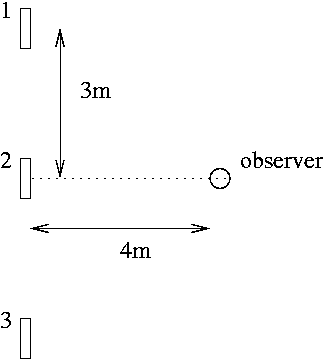
3-source interference
A printer-friendly version of this text is
available here (1 page, pdf).
This is the solution to problem # 73 from Chapter 21 of the Knight textbook. The setup is depicted in the figure.

The wave produced by the top [1] and bottom [3] speakers at the
location of the observer is
For part b) let us notice that the wavelength of the waves is
![]() . Waves from speakers 1 and 3 arrive at the
observation point with a
. Waves from speakers 1 and 3 arrive at the
observation point with a ![]() phase shift (relative to the phase at the
source) - this is due to the distance source-observer of 2.5 wavelengths,
while the wave from speaker 2 arrives
with a phase of
phase shift (relative to the phase at the
source) - this is due to the distance source-observer of 2.5 wavelengths,
while the wave from speaker 2 arrives
with a phase of ![]() (2.0 wavelengths).
Hence, it is obvious we need to shift
speaker 2 to the left by 1.0
(2.0 wavelengths).
Hence, it is obvious we need to shift
speaker 2 to the left by 1.0![]() (half of
(half of ![]() ),
so that the phase at arrival is also
),
so that the phase at arrival is also ![]() ,
and therefore constructive interference at the observation point. Note that
we could have shifted speaker 2 to the right by 1.0
,
and therefore constructive interference at the observation point. Note that
we could have shifted speaker 2 to the right by 1.0![]() with the same result (but
they specifically asked us to move the speaker to the left).
with the same result (but
they specifically asked us to move the speaker to the left).
For part c) the answer is straightforward - we use equation (3)
but with
![]() replaced by
replaced by
![]() ,
and obtain
,
and obtain
As a final observation, please note that we assumed the amplitude of the
wave from the 2-nd speaker to be still ![]() at the observation point, even
after we shifted the speaker to the left! Well, is this reasonable ...?
Perhaps not, but otherwise we don't get the answer from the textbook
:-)
at the observation point, even
after we shifted the speaker to the left! Well, is this reasonable ...?
Perhaps not, but otherwise we don't get the answer from the textbook
:-)
Last revised:November 29, 2006; solution by Sorin Codoban.